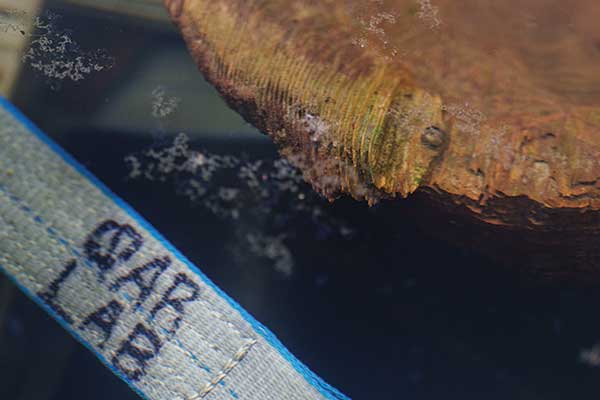QAR lab partners with Waccamaw Siouan Tribe to conserve 930-year-old canoe
Watch a video on the Lake Waccamaw canoe
It’s not uncommon for children to step on a submerged log or stump while playing in a North Carolina lake or river. But what three kids stumbled upon a couple of years ago in Lake Waccamaw and told one of their dads about was no ordinary log, but a canoe that was more than 900 years old.

“He realized that this piece of wood kept going as they kept digging, and he thankfully understood what needed to happen next,” said Kim Kenyon, lead conservator with the Queen Anne’s Revenge Conservation Laboratory on the ECU West Research Campus. “He contacted our office, the Office of State Archaeology here in North Carolina. He also contacted the chief of the Waccamaw Siouan Tribe, Mike Jacobs, whose ancestral lands are around Lake Waccamaw.”
The canoe is about 30 feet long and about 930 years old, based on carbon-14 dating, Kenyon said. Made of a single tree, it is essentially a hollowed-out log. Native Americans in North Carolina would have used fire to fell the tree and carve out the inside, Kenyon said.
State archeaologists and tribal members converged on the lake to determine the best course of action. With the permission of the landowner, the canoe was stored underneath a dock until it could be safely recovered. That day came in April.
The Waccamaw Siouan Tribe has been instrumental in the recovery and conservation effort, Kenyon said, providing a flatbed truck that could safely transport the canoe to the QAR lab and building the tank it will remain submerged in during the conservation process.
“It is special to find one intact,” Kenyon said. “Many of the other canoes in North Carolina have only been parts and pieces.” Kenyon said since the canoe is from a freshwater environment, there’s less salt to contend with, which should shorten the preservation timeline.
“We’ll go through the process of desalinating it thoroughly and documenting it,” she said. “Waterlogged wood is damaged at a cellular level, and if we just let it dry out it would crumble into pieces, which obviously no one wants to see. So we’ll take the next few years to slowly impregnate it with a material called polyethylene glycol, a waxy substance that will help strengthen it at the microscopic level so that it can eventually be dried safely.”
